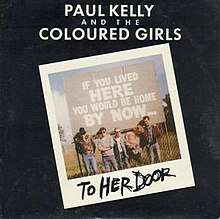To Her Door
"To Her Door" is a song by Paul Kelly and the Coloured Girls, released as a single ahead of their second album, Under the Sun (released in North America and Europe as by Paul Kelly and the Messengers). The single was released in September 1987 and reached No. 14 on the Australian singles charts.[1][2]
| "To Her Door" | ||||
|---|---|---|---|---|
 7" single cover | ||||
| Single by Paul Kelly and the Coloured Girls | ||||
| from the album Under the Sun | ||||
| A-side | "To Her Door" | |||
| B-side | "Bicentennial" | |||
| Released | September 1987 | |||
| Recorded | 1987 | |||
| Studio | Alberts Studios, Sydney | |||
| Genre | Rock | |||
| Length | 3:19 | |||
| Label | Mushroom | |||
| Songwriter(s) | Paul Kelly | |||
| Producer(s) | Alan Thorne, Paul Kelly | |||
| Paul Kelly and the Coloured Girls singles chronology | ||||
| ||||
"To Her Door" won an ARIA Music Award in 1988 for "Best Video", for its music video directed by Claudia Castle.[3][4] In 2001, the Australasian Performing Right Association (APRA) listed "To Her Door" as one the Top 30 Australian songs of all time,[5] as one of two songs written by Kelly (alongside "Treaty").[6]
In January 2018, as part of Triple M's "Ozzest 100", the 'most Australian' songs of all time, "To Her Door" was ranked number 26.[7]
Music and lyrics
The song is a ballad with country-rock underpinnings, in which Kelly tells the story of a young couple who "married early". The man is identified as "Jack" in the unedited album version, but not in the edited single mix; the woman is never named. Due to Jack's drinking, the couple's marriage "hit(s) the skids" and they end up separating. After a year, Jack writes a letter to his ex-wife, and she decides to send him the fare so he can visit both her and their two children. In the final verse, Jack is on his way to meet them, and the song ends as he arrives in town on a Sunday, wondering, "Could he make a picture and get them all to fit?"[8] The actual reunion between Jack and his family–if it even takes place–is never described.
It has been described as a brutal and beautiful attempt at reconciliation.[8] The song contains references to 'The Buttery', a drug and rehabilitation clinic on the north coast of New South Wales,[9] 'Silver Top', a Melbourne taxi company, and 'Olympic', which is a (now defunct) coach company that provided inter-state & inter-capital services.[10] In later performances of the song, Kelly replaced 'Olympic' with 'McCafferty's', which provided a Melbourne-Sydney coach service in later years.
In an interview with Debbie Kruger, Kelly indicated that the song took seven years to write.[11]
I sing little melodies into a tape recorder and every now and then I go through the tapes and have a listen. And I heard that and I thought it would be good to put words to that, it’s a good tune.[11]
Kelly uses the same protagonist in "Love Never Runs on Time" from 1994's Wanted Man and then in 1996's "How to Make Gravy" from the extended play, How to Make Gravy.[11] All three tracks appear (in live versions) on Kelly's live 8×CD boxed set, The A – Z Recordings (2010).[12]
The B-side, "Bicentennial", describes the plight of Australian Aborigines in the past and the present, highlighting aboriginal deaths in custody.[13] In 1988, Australia celebrated its bicentenary, in the song Kelly writes from the point of view of those unimpressed with 200 years of white settlement.[8]
Track listing
- "To Her Door" – 3:19
- "Bicentennial" – 3:03
Personnel
Credits:[14]
- Paul Kelly and the Coloured Girls
- Paul Kelly – acoustic guitar, vocals
- Michael Barclay – drums, backing vocals
- Peter Bull – keyboards
- Steve Connolly – guitar (electric), backing vocals
- John Schofield – bass guitar
- Additional musicians
- Recording details
- Producer – Alan Thorne, Paul Kelly
Releases
| Format | Country | Label | Catalogue No. | Year |
| 7" single | AUS | Mushroom | White K412 | 1987 |
References
- Kent, David (1993). Australian Chart Book 1970–1992. St Ives, N.S.W.: Australian Chart Book. ISBN 0-646-11917-6.
- "Discography Paul Kelly". Australian Charts Portal. Retrieved 2008-08-15.
- "ARIA Awards 2008: History: Winners by Artist search result". Australian Recording Industry Association (ARIA). Archived from the original on 2014-03-25. Retrieved 2008-08-19.
- Garcia, Alex S. (2008). "Paul Kelly - artist videography". mvdbase.com. Retrieved 2008-08-19.
- Kruger, Debbie (2001-05-02). "The songs that resonate through the years" (PDF). Australasian Performing Right Association (APRA). Retrieved 2008-08-25.
- "Australasian Performing Right Association (APRA) search engine". APRA. Retrieved 2008-10-12. Note: requires user to input song title e.g. TO HER DOOR
- "Here Are The Songs That Made Triple M's 'Ozzest 100'". Musicfeeds. 27 January 2018. Retrieved 4 January 2020.
- Ford, Karen (6 February 2006). "Don't start me talking - lyrics". The Age. Archived from the original on 22 October 2009. Retrieved 15 March 2010.
- Writer, Larry (10 November 2007). "Buttery rehab puts its ambitions into music". The Australian. Retrieved 15 March 2010.
- Haby, Steven (November 2001). "Express Coach Timetables from the 1980s" (PDF). The Times (Journal of the Australian Association of Time Table Collectors). Vol. 18 (No. 11) (Issue No. 212): 6–7. Retrieved 7 December 2019.
- Kruger, Debbie (December 2002). "Paul Kelly words are never enough". APRAP. Retrieved 15 March 2010.
- "The A – Z Recordings". iTunes. Apple Inc. 24 September 2010. Retrieved 19 May 2012.
- Speelman, Paul (26 November 1987). "Paul Kelly goes for the jugular". The Age. Retrieved 15 March 2010.
- Holmgren, Magnus. "Paul Kelly". Australian Rock Database. Passagen.se (Magnus Holmgren). Archived from the original on 22 October 2013. Retrieved 21 March 2014.